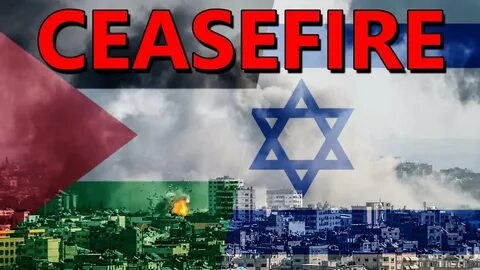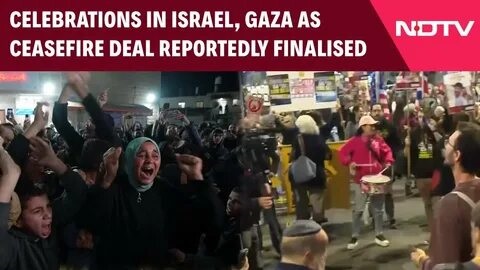
Mohammed bin Abdulrahman Al Thani, Qatar’s prime minister and foreign minister, announced late on January 15 that Doha, Cairo and Washington had brokered an agreement between Israel and Hamas to release the hostages held in Gaza and declare a ceasefire in the enclave. He said the deal was supposed to take effect on Sunday, January 19.
According to the Qatari official, during the initial 42-day phase, Hamas will release 33 Israeli military and civilian female hostages, as well as wounded civilians, children, and the elderly, in exchange for the release of Palestinian prisoners from Israeli jails. Israel will withdraw its forces at least 700 meters away from the Gaza border, Al Jazeera reported, citing a source. In the first phase of the deal, both parties plan to negotiate the terms of subsequent phases, including the complete withdrawal of Israeli troops from Gaza.
Israel, the Palestinian movement Hamas, the US and Qatar have officially signed a deal on a ceasefire in the Gaza Strip and the release of Israeli hostages, TASS reports, quoting the Axios news website.
According to the sources, US President Joe Biden’s Middle East envoy Brett McGurk, US President-elect Donald Trump's envoy Steve Witkoff and Qatari and Egyptian mediators worked on the deal.
According to Axios, "the Israeli security cabinet was supposed to convene on Thursday morning to vote on the agreement, but several last minute disputes in the negotiations in Doha delayed the official signing of the agreement a day." "The delay in the vote will postpone the start of the ceasefire and the release of the first three hostages from Sunday to at least Monday, according to Israeli officials," the media outlet notes.
The signing was delayed because of a disagreement about the final list of Palestinian prisoners to be released as part of the deal. Hamas demanded to swap several military leaders serving life sentences for planning and orchestrating terrorist attacks, Axios points out.
Al Arabiya reported earlier, citing sources, that Hamas and Israel had signed a deal to declare a ceasefire in Gaza and release Israeli hostages in exchange for Palestinians prisoners.
The plan includes the release of Israeli captives and Palestinian prisoners, the crossing of wounded Palestinian combatants and civilians to Egypt and the return of internally displaced people to their homes in northern Gaza.
Israel and the Palestinian movement Hamas on Wednesday agreed to a ceasefire in the Gaza Strip, potentially bringing an end to Israel's devastating 15-month onslaught on the enclave that killed at least 46, 707 Palestinians.
Qatari Prime Minister Mohammed bin Abdulrahman bin Jassim al-Thani announced the deal on Wednesday during a press conference in Doha, saying the agreement will take effect on 19 January.
The Qataris, alongside the Egyptians, helped negotiate the agreement with Israel, while the incoming US administration of President-elect Donald Trump applied pressure on the Israelis, Haaretz reported.
Trump lauded the "epic" ceasefire, saying it would not have happened without his return to the White House.
The agreement adds new details to an agreement initially reported by Middle East Eye in 2024.
The agreement includes provisions for the exchange of prisoners, return of internally displaced civilians to their homes in the north, and the crossing of wounded Palestinian combatants and civilians to Egypt via the Rafah crossing in southern Gaza.

Here is the full text of the new details in the agreement obtained by Middle East Eye:
Appendix I
Practical procedures and mechanisms to implement the Agreement for the exchange of Israeli hostages and Palestinian Prisoners and the return to a sustainable calm which would achieve a permanent ceasefire between the two sides.
- Stage two preparations:
The parties and the mediators' objective is to achieve a final consensus to implement the May 27 2024 Agreement on the exchange of hostages and prisoners and return to a sustainable calm which would achieve a permanent ceasefire between the Parties.
All procedures in the first stage will continue in stage 2 so long as the negotiations of the conditions of implementing stage 2 are ongoing and the guarantors of this Agreement shall work to ensure that negotiations continue until an agreement is reached.
- Israeli forces withdrawal:
Withdrawal of Israeli forces eastwards from densely populated areas along the borders of the Gaza strip, including Wadi Gaza (Netzarim axis and Kuwait roundabout).
The Israeli forces will be deployed in a perimeter (700) metres with an exception at 5 localised points to be increased no more than (400) additional meters that the Israeli side will determine, south and west of the border, and based on the maps agreed upon by both sides which accompany the agreement.
- Prisoner Exchange:
- The 9 ill and wounded from the list of 33 will be released in exchange for the release of 110 Palestinian prisoners with life sentences.
- Israel will release 1000 Gazan detainees from 8 October 2023 that were not involved in 7 October 2023
- The Elderly (men over 50) from the list of 33 will be released in exchange for an exchange key of 1:3 life sentences + 1:27 other sentences.
- Ebra Mangesto and Hesham el-Sayed - will be released according to an exchange key of 1:30, as well as 47 Shalit prisoners.
- A number of Palestinian prisoners will be released abroad or in Gaza based on lists agreed upon between both sides.
- Philadelphi corridor:
- The Israeli side will gradually reduce the forces in the corridor area during stage 1 based on the accompanying maps and the agreement between both sides.
- After the last hostage release of stage one, on day 42, the Israeli forces will begin their withdrawal and complete it no later than day 50.
- Rafah Border Crossing:
- The Rafah crossing will be ready for the transfer of civilians and for the wounded after the release of all women (civilian and soldiers). Israel will work toward the readiness of the crossing as soon as the agreement is signed.
- Israeli forces will redeploy around the Rafah Crossing according to the attached maps.
- 50 wounded military individuals will be allowed to cross daily accompanied by (3) individuals. Each individual crossing will require Israeli and Egyptian approval.
- The crossing will be operated based on the August 2024 discussions with Egypt.
- Exit of ill and wounded civilians:
- All ill and wounded Palestinian civilians will be allowed to cross via Rafah border crossing, according to section 12 in the 27 May 2024 agreement.
- Return of unarmed internally displaced (Netzarim Corridor):
- The return is agreed based on the 27 May 2024 agreement section 3-a and 3-b.
- On day 7, the internally displaced pedestrians will be allowed to return north, without carrying arms and without inspection via Rashid street. On day 22, they will be allowed to return north from the Salahudin street as well, without inspection.
- On day 7, vehicles and any non-pedestrian traffic will be allowed to return north of Netzarim corridor after vehicle inspection which will be performed by a private company which will be determined by the mediators in sync with the Israeli side, based on an agreed upon mechanism.
- Humanitarian aid protocol:
a. Humanitarian aid procedures under the agreement will be done subject to the humanitarian protocol agreed upon under the supervision of the mediators.
P.S. The ‘Washington Post’ informs: “Behind closed doors, Netanyahu has been promising his far-right allies that the war could resume after that initial phase, during which Hamas is to gradually release 33 hostages in exchange for the freeing of more than 1,000 Palestinian prisoners, according to three people familiar with the negotiations.”
read more in our Telegram-channel https://t.me/The_International_Affairs

 14:38 17.01.2025 •
14:38 17.01.2025 •






















